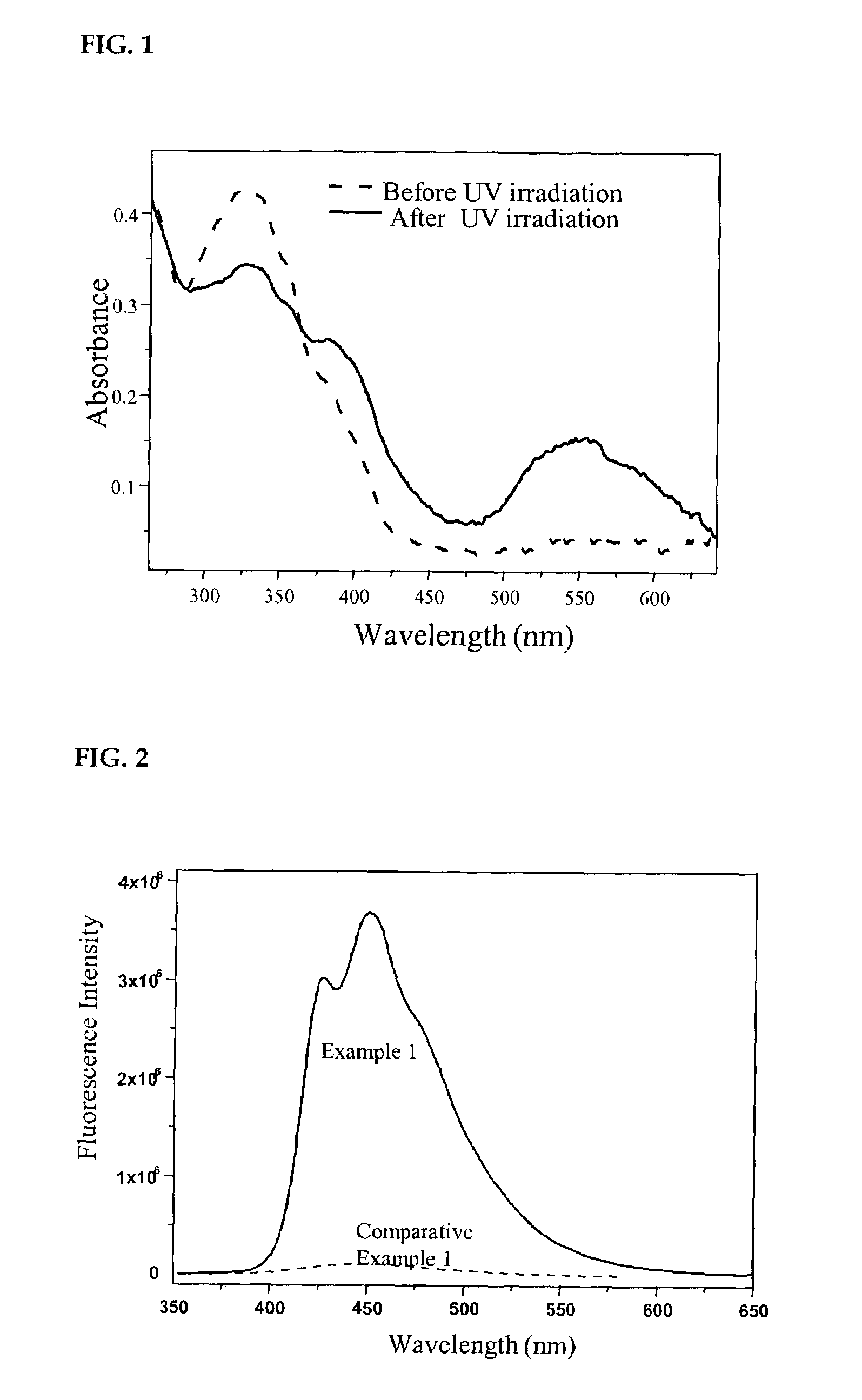Photochromic fluorescent polymer and preparation method thereof
a fluorescent polymer and photochromic technology, applied in the field of photochromic fluorescent polymer and a preparation method thereof, can solve the problems of gradual erasure of the record, short wavelength of 240 nm, and drawbacks of photochromic diarylethene compounds, and achieve excellent photochromic and fluorescent properties, easy to manufacture thin films, and excellent solubility in organic solvents.
- Summary
- Abstract
- Description
- Claims
- Application Information
AI Technical Summary
Benefits of technology
Problems solved by technology
Method used
Image
Examples
example 1
Preparation of Photochromic Fluorescent Polymer
[0045]A compound of formula (1) of the present invention, especially a structure (1), was prepared by the following procedure as in Scheme 1.
[0046]
[0047]To chloroform were dissolved 1.4 g of diarylethylene substituted with formyl group of structure 2 and 2.1 g of the compound of structure 3. Potassium t-butoxide (1.5 g) was dissolved in 40 mL of ethanol. The ethanol solution was slowly added to the chloroform solution while stirring and the mixture was reacted at 25° C. for 24 hours. After removing chloroform, the reaction products were washed with excess of methanol to give the desired polymer. Yield was 80% and a weight average molecular weight was 2120. 1HNMR (CDCl3, ppm) δ 2.2, 2.5, 6.6, 7.1–7.6.
experimental example
Photochromic Analysis and Fluorescence Analysis
[0048]The solution was prepared by dissolving the polymer prepared in Example 1 in chloroform to give a concentration of 10 μM. An ultraviolet light was irradiated to the chloroform solution in the spectrophotometer and result was represented in FIG. 1. A short wavelength of 290 nm in wavelength was irradiated to the chloroform solution in the fluorescence spectrometer and result was represented in FIG. 2.
[0049]When an ultraviolet light was irradiated to the polymer prepared in Example 1 of the present invention, the solution containing the polymer turned its color to red. In other words, it was proved that the polymer had photochromic property. As shown in absorption spectra of FIG. 1, new absorption band was produced in the range of the visible region and the polymer had a quantum yield of 40% derived from absorbance change as a function of irradiation time.
[0050]Further, it was noted that the polymer prepared in Example 1 of the pres...
examples 2 to 10
Preparation of Photochromic Fluorescent Polymer
[0053]Experiments were performed the same as in Example 1, excepting that a reactant, catalyst, solvent and content, temperature, and reaction time were modified as shown in Table 1 to provide the following photochromic fluorescent polymers.
[0054]
TABLE 1ExamplesCategory1234567891011ReactantStructure 211.422(g)Structure 322.13.7Structure 4322Structure 541Structure 651.2Structure 761Structure 871Structure 981Structure 1091.5Structure 11101.51.5Structure 12111.1Structure 13121.5Structure 14131.51.5Structure 15141.5Structure 16151.5Structure 17162SolventChloroform20202020202050(mL)Benzene101010Acetonitrile10Cat.Potassium-t-1.5 / 1.75 / 1.75 / 1.75 / 1.75 / 1.75 / 1.75 / 1.75 / 2.6(g) / EtOHbutoxide40 / 40 / 40 / 40 / 404040 / 40 / 80(mL)Sodiumethoxide1.75 / 1.75 / / 40 / 40Polymerization2525254025252525252520temperature (° C.)Reaction time (hour)2465254865656572657284Yield (%)80556540603555758565701. Structure 22. Structure 33. Structure 44. Structure 55. Structure 66. Structu...
PUM
| Property | Measurement | Unit |
|---|---|---|
| Temperature | aaaaa | aaaaa |
| Time | aaaaa | aaaaa |
| Angle | aaaaa | aaaaa |
Abstract
Description
Claims
Application Information
 Login to View More
Login to View More - R&D
- Intellectual Property
- Life Sciences
- Materials
- Tech Scout
- Unparalleled Data Quality
- Higher Quality Content
- 60% Fewer Hallucinations
Browse by: Latest US Patents, China's latest patents, Technical Efficacy Thesaurus, Application Domain, Technology Topic, Popular Technical Reports.
© 2025 PatSnap. All rights reserved.Legal|Privacy policy|Modern Slavery Act Transparency Statement|Sitemap|About US| Contact US: help@patsnap.com



